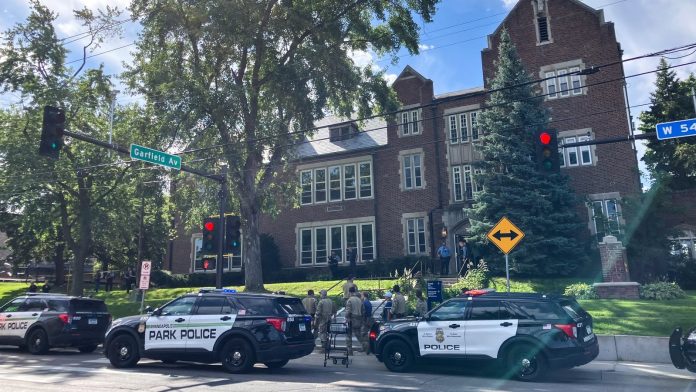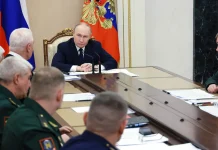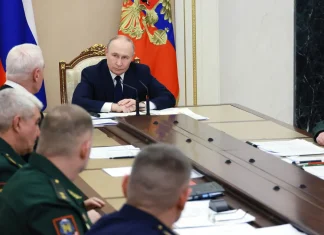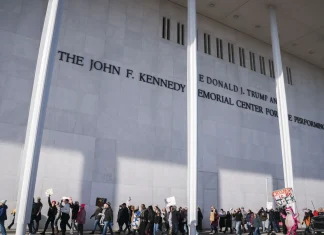
A Sunday Shattered: The Tragedy at Minneapolis’ Annunciation Catholic School
There are moments when news arrives with a sharpness that cuts through the usual noise, demanding to be felt as much as understood. On a quiet morning in southeast Minneapolis, a place where childhood laughter should have filled the halls of Annunciation Catholic School, terror instead echoed through the chapel’s fragile stained-glass windows.
Two young lives—children of just eight and ten years—were stolen in an instant, their innocence extinguished by gunfire that pierced a sanctuary meant for prayer and peace. Seventeen others, children and adults alike, were wounded, some fighting for their lives in hospital beds no one ever expected they’d occupy on a school morning.
The Unthinkable in a House of Worship
It was during a Mass service that the shooting unfolded, the assailant firing through the school chapel’s windows as children knelt in pews. The image feels almost surreal, a violent intrusion into a sacred rite—an attack on faith itself as much as on fragile flesh. Minneapolis Police Chief Brian O’Hara expressed his heartbreak and outrage plainly at a press briefing:
“This was a deliberate act of violence against innocent children and other people worshiping. The sheer cruelty and cowardice of firing into a church full of children is absolutely incomprehensible.”
The gunman, later identified by FBI Director Kash Patel as 23-year-old local Robin Westman, ended his own life at the scene. But the ripple effects of his actions have rippled across a community, a city, and the nation—rekindling a worn yet urgent debate on violence in American schools, the sanctity of worship spaces, and the shadow of hate crimes in modern society.
A Grim Pattern Amid Ongoing Violence
Statistics provide grim context for what feels like a uniquely atrocious event. This shooting is one among more than 140 school shootings nationwide so far this year, according to the K-12 School Shooting Database. But this wasn’t just another incident; it was an assault on faith and innocence intertwined.
“Don’t just say this is about thoughts and prayers right now,” Minneapolis Mayor Jacob Frey implored the nation, his voice thick with anger and sorrow. “These kids were literally praying. It was the first week of school. They were in a church.”
The shooter’s armament was chillingly comprehensive: a rifle, a shotgun, and a pistol. Yet, his criminal record was not extensive—a stark reminder that danger can lurk behind the most unassuming facades. Local records also revealed a haunting connection: the shooter’s mother had once worked at Annunciation Church, binding this act of violence with a personal and community history.
Unfolding Chaos in a Tight-Knit Community
Annunciation Catholic School is a small private elementary, home to roughly 395 students. Nestled within a residential area, coupled closely with the church itself, this school is woven tightly into the fabric of the neighborhood. The shockwaves sent by the shooting cannot be overstated.
One parent, her voice trembling amidst the rush of emergency responders and flashing lights, caught the chaotic scene in words: “We were told to get down, to hide, but it was the chapel doors barricaded with planks outside that saved many lives. It felt like a nightmare unfolding in real time.”
Nearby hospitals soon filled with victims: fifteen children, two adults, many bearing the gravity of gunshot wounds. Their names mostly anonymous now, but their stories—some just beginning—will be carried by a community grappling with profound grief.
Beyond Minneapolis: America’s Gun Violence Epidemic
While this tragedy feels local and intimate, it is also a stark thread in the broader tapestry of American gun violence. Minnesota has generally fared better than many states—gun death rates here fluctuate below the national average, and the state enforces background checks for all gun sales. But the patterns of violence are stubborn, resistant to simple solutions.
This incident follows a wave of recent tragedies in the Midwest, including a political assassination in Minnesota that shook state politics and public confidence. In Minneapolis alone, there have been three other shootings over just a few days, collectively leaving more dead and wounded. The city recorded 54 homicides last year—a decline from the previous year’s peak of 71, yet still almost double the total from 2019.
What Drives This Darkness?
Investigators are treating the massacre as both an act of domestic terror and a hate crime specifically targeting Catholics. This raises sobering questions about the motivations behind such violence: what fuels a young man to weaponize faith spaces? What undercurrents of unchecked resentment or radicalization swirl beneath the surface?
Kash Patel of the FBI spoke of probing online videos tied to the suspect—social footprints that authorities hope will peel back the layers behind this horrific act. For a generation growing up online, is there an invisible pipeline churning out extremist beliefs, turning alienation into annihilation?
A Community Mourns, A Nation Reflects
In Minneapolis, grief feels palpable. The city’s fabric has been rent yet again by a shooting that stole children’s lives and innocence. Across the country, parents clutch their own youngsters a little tighter, schools reconsider security measures, and debates about gun laws, mental health, and community safety intensify once more.
President Donald Trump, briefed on the shooting, joined the chorus of calls for prayers, emphasizing the seriousness with which federal law enforcement was responding. Homeland Security Secretary Kristi Noem assured the public that close coordination with local authorities was underway.
But prayers, as Mayor Frey insists, are not enough. They never are. How do we translate sorrow into action? How do we protect the sanctuaries where children learn, play, and pray?
The Human Faces Behind the Tragedy
Let’s pause to imagine: an eight-year-old clutching a missal, eyes closed in reverence, suddenly thrust into chaos. An entire pew of children, terror-stricken, seeking shelter beneath the pews they once sat upon in peace. Teachers and parents racing against time, hearts lodged in their throats, screaming for safety.
One mother recounted the frantic moments of reunion at the school gate. “I grabbed my daughter and held her so tight…I prayed that this nightmare would end.”
The resilience of this community, however, gleams through the darkness. Local volunteers have mobilized; counselors and trauma experts are dispatched. Small gestures—a warm meal, a quiet word, a shared candlelight vigil—become lifelines.
We Are All Witnesses
This tragedy invites us, as readers and global citizens, into a vital conversation about violence, belonging, and faith. It challenges us to reckon with the vulnerability of children, the sanctity of religious spaces, and the urgent need for change that transcends partisanship.
Could this be a call to reimagine our collective commitments—toward empathy, toward safety, toward confronting the hatred that fuels such acts? When a church becomes a crime scene, the wound is deeper than the physical; it cuts at the very notion of sanctuary and community.
What Next?
As investigations continue and the community begins the long journey of healing, we must ask ourselves: how do we honor the memory of the eight and ten-year-olds lost so brutally? How do we support the survivors and loved ones? And perhaps most difficult — how do we prevent this from happening again?
In the city of Minneapolis, this Sunday morning will never again be the same. But from the wreckage of sorrow, voices rise—demanding justice, compassion, and change. The world watches, poised at a crossroads where grief could either harden into despair or ignite a renewed fight for a safer future.
Isn’t it time we choose the latter?









